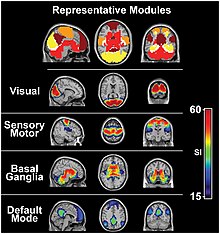
Back Sensoriese senuweestelsel Afrikaans Sistema sensorial AN جهاز إحساس Arabic সংবেদন তন্ত্ৰ Assamese Sistema sensorial AST Сенсор системаһы Bashkir Сэнсорная сістэма Byelorussian Сэнсорная сыстэма BE-X-OLD Сетивна система Bulgarian সংবেদী স্নায়ুতন্ত্র Bengali/Bangla


The sensory nervous system is a part of the nervous system responsible for processing sensory information. A sensory system consists of sensory neurons (including the sensory receptor cells), neural pathways, and parts of the brain involved in sensory perception and interoception. Commonly recognized sensory systems are those for vision, hearing, touch, taste, smell, balance and visceral sensation. Sense organs are transducers that convert data from the outer physical world to the realm of the mind where people interpret the information, creating their perception of the world around them.[1]
The receptive field is the area of the body or environment to which a receptor organ and receptor cells respond. For instance, the part of the world an eye can see, is its receptive field; the light that each rod or cone can see, is its receptive field.[2] Receptive fields have been identified for the visual system, auditory system and somatosensory system.
- ^ Krantz, John. "Experiencing Sensation and Perception - Chapter 1: What is Sensation and Perception?" (PDF). p. 1.6. Retrieved May 16, 2013.
- ^ Kolb, Bryan (2003). Winshaw, Ian Q. (ed.). Fundamentals of human neuropsychology (5th ed.). New York, NY: Worth Publishers. ISBN 0-7167-5300-6. OCLC 55617319.
© MMXXIII Rich X Search. We shall prevail. All rights reserved. Rich X Search